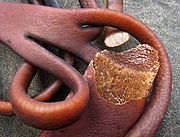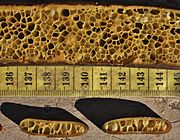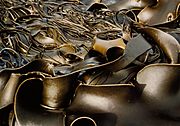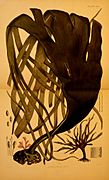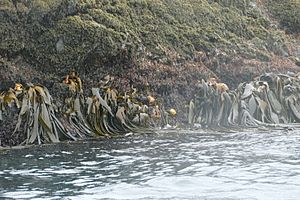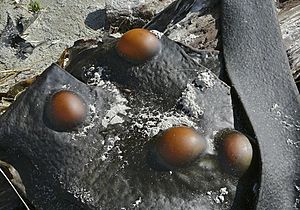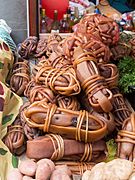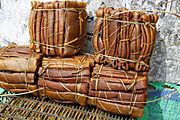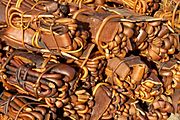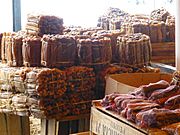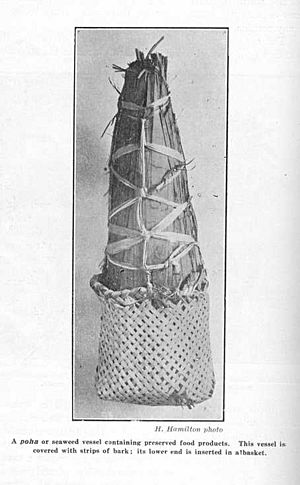Cochayuyo facts for kids
Quick facts for kids Cochayuyo |
|
|---|---|
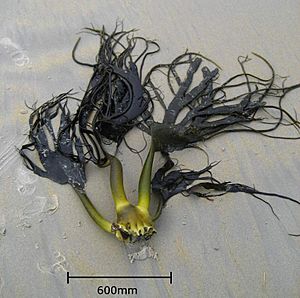 |
|
| Durvillea antarctica. Washed up on Sandfly Bay, Otago, New Zealand | |
| Scientific classification | |
| Genus: |
Durvillaea
|
| Species: |
antarctica
|
Durvillaea antarctica, also known as cochayuyo and rimurapa, is a very large and strong type of southern bull kelp. You can find it growing along the coasts of Chile, southern New Zealand, and Macquarie Island. This amazing alga (a type of seaweed) doesn't have air bubbles to float. Instead, it has a special honeycomb-like structure inside its blades. This unique structure helps the kelp float and also protects it from powerful ocean waves.
Contents
Naming and Discovery
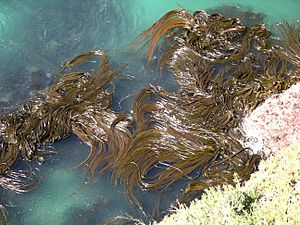
This species was first described in 1822. Back then, it was called Fucus antarcticus. Later, in 1892, its name was changed to Durvillaea antarctica. The name Durvillaea honors a French explorer named Jules Dumont d'Urville. The second part, antarctica, comes from Latin and simply means "from the Antarctic region."
In 2012, scientists looked closely at this kelp again. They found a new species called Durvillaea poha. Before this, D. poha was thought to be just a different type of Durvillaea antarctica. D. poha is special because it also has the honeycomb structure that helps it float, just like D. antarctica.
You can find D. poha only in southern New Zealand and on some smaller islands nearby. But D. antarctica lives in more places, including New Zealand, Chile, and other subantarctic islands. Sometimes, both types of kelp grow together in southern New Zealand. However, D. poha often grows a bit higher up on rocks or in calmer bays where the waves are not as strong. D. poha usually has wider blades and can look more orange than D. antarctica.
What it Looks Like
The blades of Durvillaea antarctica can be green or golden brown. They feel a bit like leather. The special honeycomb pattern inside the blade makes it very strong and helps it float. This floating ability is super important! It allows the kelp to travel huge distances across the ocean if it breaks off from the rocks.
When kelp rafts float, they can carry many small sea creatures with them. This helps these creatures spread to new coastlines. Scientists have seen D. antarctica float for up to 210 days. During this time, strong winds can push these kelp rafts as far as 10,000 kilometers (about 6,200 miles)! Things like water temperature, sunlight, and winds affect how well the kelp floats and how fast it travels.
It is believed that this "rafting" helped many sea species move to new places after the last Ice Age. During that time, ice cleared many sub-Antarctic shores.
The part of the kelp that sticks to rocks is called a holdfast. The holdfast of D. antarctica is very big and strong. It's incredibly hard to pull off! This kelp has to withstand forces as strong as winds blowing at 1,100 kilometers per hour (about 680 mph) on land. Sometimes, small worms and molluscs (like snails) eat the holdfast. This can weaken it and cause the kelp to break off. It's also common for the rock itself to break before the holdfast lets go! This contributes to erosion in some areas.
- Parts of D. antarctica
Life Cycle
Durvillaea antarctica reproduces by releasing eggs and sperm into the water. These are made on special parts of its frond (leaf-like part). A large kelp plant can produce 100 million eggs in just twelve hours! The time of year when they reproduce changes depending on the location, but it's usually during the winter months.
Where it Lives
Durvillaea antarctica is found all around the southern parts of the world, between 29°S and 55°S latitude. This includes Chile, southern New Zealand, and Macquarie Island. It was first discovered near Cape Horn in Chile.
You can find this kelp on coasts that are very exposed to waves. It uses its strong holdfast to attach firmly to the rocks.
Creatures and Diseases
The holdfasts of D. antarctica are often home to many different small creatures. These animals, called epifauna, often burrow into and eat the kelp. In New Zealand, some of these creatures include small crustaceans and molluscs (like snails and limpets).
When D. antarctica plants break off from the rocks, especially during storms, they float away as rafts. These kelp rafts can travel very far in the ocean, carried by currents. The small creatures living inside the holdfasts can also travel along. This helps them spread to new places and affects how their populations grow.
Sometimes, the fronds of D. antarctica can get infected by a tiny algae called Herpodiscus durvillaeae. This parasite also seems to spread by riding along on the floating kelp rafts.
How People Use It
Chilean Culture
Used in Food
In Chile, people gather the stems and holdfasts of D. antarctica and a similar kelp, D. incurvata. They use it in many Chilean recipes, like salads and stews. In the Quechua language, this kelp is called cochayuyo (which means "lake weed"). The Mapuche people, who are indigenous to Chile, call it collofe or kollof.
Māori Culture
The Māori people of New Zealand use the blades of D. antarctica (and D. poha) to make traditional pōhā bags. These bags are used for carrying and storing food and fresh water. They can also be used to carry live shellfish or to make clothing and sports equipment. Pōhā bags are especially linked to the Ngāi Tahu tribe. They often use them to carry and store young muttonbird (tītī) chicks. In the Māori language, this species is called rimurapa.
See also
 In Spanish: Cochayuyo para niños
In Spanish: Cochayuyo para niños


